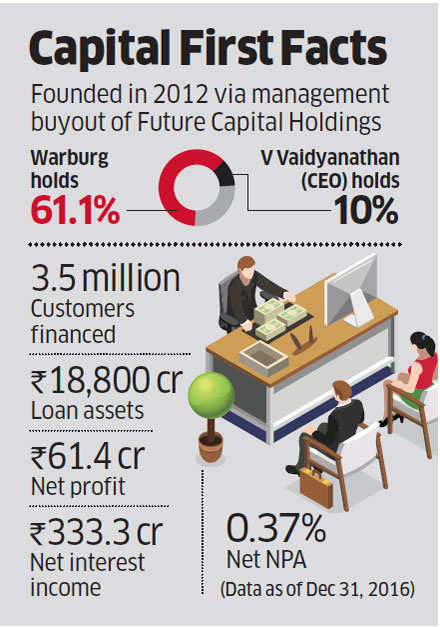PE giant Warburg Pincus plans to sell 10% stake in consumer lender Capital First to take advantage of a five-fold jump in share price and a strong equity market hovering at all-time highs.
The US-based PE will make one of its best exits in India, recovering nearly the entire capital invested in the company through this single transaction. Warburg, which has invested about Rs 790 crore in Capital First in multiple rounds since 2012, expects to raise about Rs 712 crore through the share sale.
Warburg bought the shares at Rs 162 apiece. The shares have since zoomed, and on Monday the scrip closed at Rs 779.55 on the Bombay Stock Exchange.
Warburg owned 61.1% in Capital First as on December 31, 2016, its corporate presentation showed. The company recorded a net profit of Rs 61.4 crore with a net interest income of Rs 333.3 crore.
 |
“The conversation has been doing the rounds for some time now. Warburg’s partial exit would be through block deals in the open market, though the official mandate and precise timing of the deal are not yet known,” said one of the sources directly aware of the negotiations.
Big Return on Investment
Capital First was incorporated in 2012 following a management buyout of listed nonbanking financial company Future Capital Holdings. Warburg acquired Future Group’s 54% stake in Future Capital, backing its CEO V Vaidyanathan, and renamed the company Capital First. Vaidyanathan, a former ICICI Bank executive director, owned 10% in Future Capital. Warburg retained him at the helm, a strategy the fund prefers across its portfolio companies.
Capital First has financed more than 3.5 million customers and boasts loan assets of Rs 18,800 crore as of December 31, 2016. The company provides retail and consumer loans, mortgaged or securitised loans and also lends to micro, small and medium enterprises. With net NPA (non-performing assets) of 0.37%, Capital First has transformed from a wholesale lending NBFC to a strong retail lending NBFC.
Warburg, one of the oldest and most proficient investors in India, has deployed $3.8 billion across 51companies since 1997 ranging from Kotak Mahindra Bank and Alliance Tire to Ambuja Cement and Laurus Labs. The fund is looking to deepen its India involvement and plans to invest $8 billion in the next 10 years, its co-CEOs Charles R Kaye and Joseph P Landy told ET in an interview in January.
“Capital First’s margin trajectory continues to improve with 30 bps (basis points) QoQ (quarter on quarter) expansion in Q3 to 9.1% as it continued to improve its mix in the high-yielding segments like consumer durable, two-wheeler and used car loan. Margin benefit also was seen on lower cost of funds,” Prabhudas Lilladher said in a note in February.
Indian stock markets have been on a roll. The Sensex is the best-performing index in Asia in the first quarter of this year, recording 11% gains, compared with a 5.36% rise in the Shanghai Composite. Hong Kong’s Hang Seng (10%) and Korea’s Kospi (8%) are only two major Asian indices standing up to India in terms of equity returns, Credit Suisse said in a note last week.
“It’s quite natural for the PE fund to take advantage of the sharp gains in capital markets thereby ensuring unprecedented return on investments. I believe this exit will prove how fruitful the Indian market is for strong and committed long-term investors such as global PE funds and pension funds,” said Rajesh Narain Gupta, managing partner at law firm SNG & Partners.
